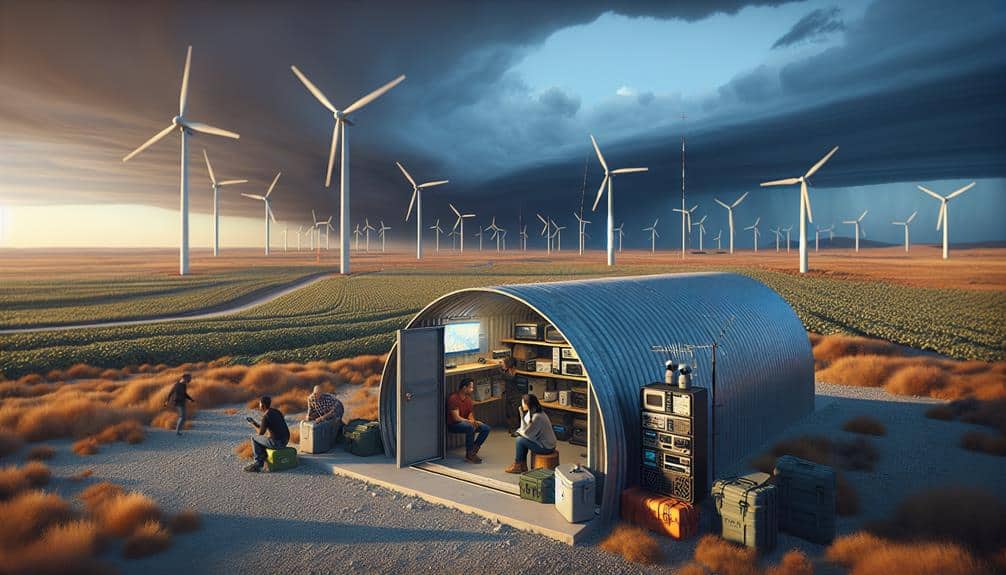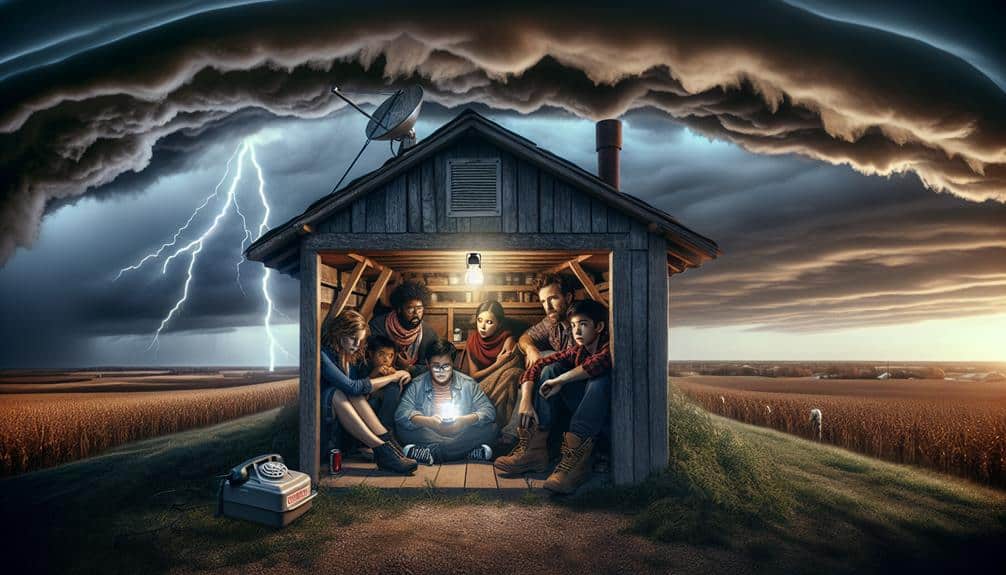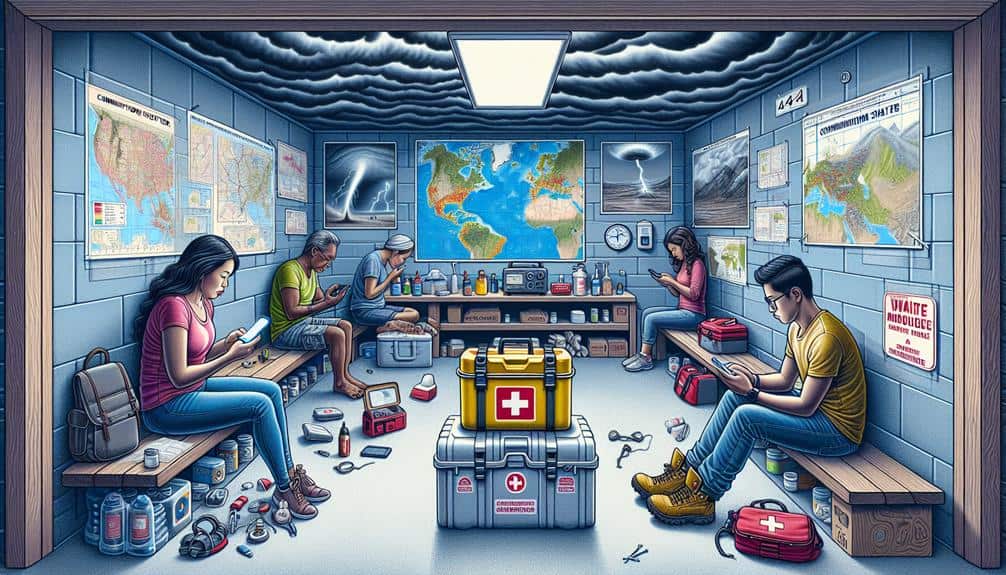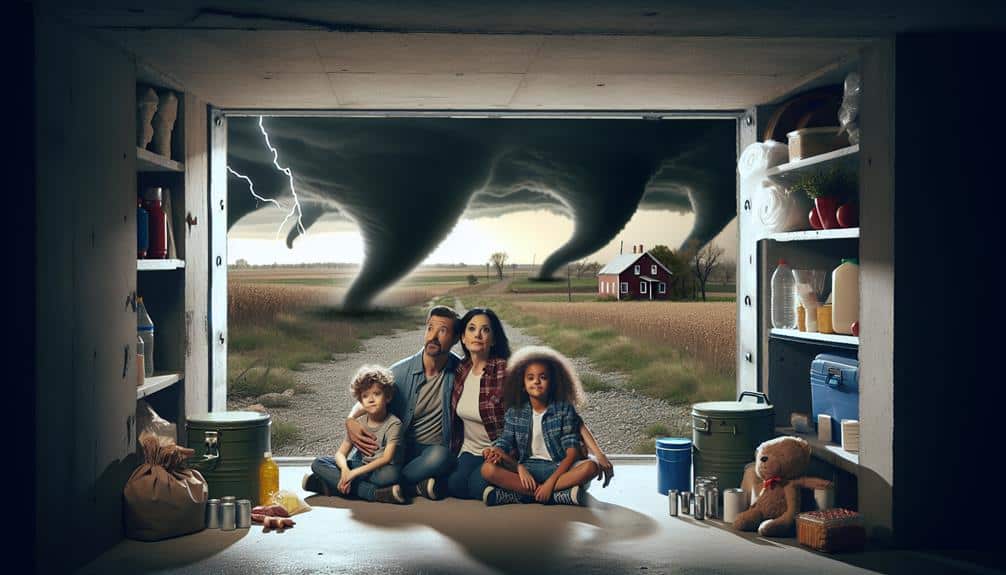When a storm hits, knowing where storm shelters are and having dependable communication devices can be lifesaving. We need battery-powered radios, mobile phones with backup power, and satellite phones for staying informed and coordinated with rescue services. Urban areas should have storm shelters in easily reachable locations like community centers and underground parking garages. In rural areas, connectivity might rely more on satellite phones and emergency sirens. Integrating these tools into our safety plans guarantees we're prepared and connected during emergencies. Discover more about optimizing safety with efficient communication devices in storm shelters.
Key Points
- Ensure urban storm shelters are equipped with battery-operated radios and satellite phones for reliable communication during emergencies.
- Strategically position shelters in accessible urban locations to provide quick refuge and robust emergency response.
- Utilize mobile apps for receiving real-time emergency notifications and sharing locations to enhance safety.
- Equip rural storm shelters with satellite phones and community alert systems for effective communication in remote areas.
Importance of Communication Devices
In storm shelters, having dependable communication devices is crucial for staying informed and coordinating with rescue services. When we talk about emergency preparedness, effective communication strategies are at the heart of staying safe.
A reliable communication device guarantees we can access real-time updates about weather conditions and receive essential instructions from authorities. This level of preparedness can make the difference between safety and danger during a storm.
Our communication strategies should include a mix of devices, such as battery-operated radios, mobile phones with backup power, and satellite phones. Each of these tools has its strengths.
For instance, battery-operated radios can provide continuous updates even when the power is out, while mobile phones allow for direct communication with emergency services and loved ones. Satellite phones are indispensable when cell networks are down.
Urban Storm Shelter Options
When considering urban storm shelter options, we should focus on the accessibility of public shelters. These locations provide practical and reliable refuge during severe weather.
The safety offered by underground parking garages is another crucial aspect to consider. They can serve as effective storm shelters in urban areas.
Lastly, the availability of community center shelters is also important. These shelters can provide a secure environment during severe weather events.
Let's explore how each option can serve our needs in an urban environment.
Public Shelter Accessibility
Urban storm shelters must be strategically positioned to guarantee quick and easy access for all city residents during emergencies. By employing effective shelter location strategies, we enhance public safety and make sure that everyone can reach a safe haven in the shortest time possible. These shelters need to be distributed throughout the city, particularly in densely populated areas and regions prone to severe weather. Accessibility is key; no one should feel stranded or out of reach of safety when a storm hits.
Communication device accessibility within these shelters is equally crucial. We all rely on our smartphones and other devices to stay informed and connected, especially during a crisis. Ensuring robust connectivity in storm shelters enables efficient emergency response and helps us stay in touch with loved ones. Adequate power supplies and signal boosters can make a significant difference in maintaining communication during emergencies.
Moreover, public information campaigns should highlight shelter locations and the significance of carrying charged communication devices. By understanding where to go and how to stay connected, we can better navigate the challenging circumstances that severe weather often brings. Ensuring both physical and digital accessibility in urban storm shelters is essential for our collective safety and freedom.
Underground Parking Garages
Many cities could repurpose underground parking garages as effective storm shelters. These structures are already designed to withstand significant forces, making them ideal for providing protection during severe weather. By adhering to strict safety guidelines and stocking essential emergency supplies, we can guarantee these shelters are both safe and functional.
Underground parking garages offer several advantages for urban storm shelters:
- Structural Integrity: Built to support heavy vehicles, these garages are inherently strong and can endure high winds and debris.
- Accessibility: Often located in central urban areas, they're easily reachable to a large number of people.
To maximize safety, it's essential to follow established safety regulations. This includes reinforcing structures where necessary and ensuring proper ventilation to prevent carbon monoxide build-up.
Emergency supplies such as water, non-perishable food, first-aid kits, and communication devices must be readily available to address basic needs and maintain communication with emergency responders.
Community Center Shelters
Community centers can serve as crucial storm shelters due to their central locations and existing infrastructure. They often provide a reliable refuge during severe weather, thanks to built-in shelter amenities and established safety protocols. These facilities are strategically situated within urban areas, making them accessible to a large number of residents who may not have personal storm shelters.
When we seek safety in a community center during a storm, we benefit from a range of amenities designed to guarantee comfort and security. These typically include reinforced structures, emergency power supplies, and first-aid stations. Additionally, many centers are equipped with communication devices to keep us connected with emergency services and loved ones.
Adherence to strict safety protocols is another key advantage of using community centers as storm shelters. Staff are often trained in emergency response, and the facilities are regularly inspected to meet safety standards. Clear signage and designated safe zones help us navigate the space efficiently, reducing panic and confusion during a crisis.
Rural Shelter Communication Solutions

Reliable communication in rural areas is crucial for guaranteeing timely access to storm shelters. In rural communities, emergency notifications can be the difference between life and death. However, communication challenges in remote locations often make it more difficult to distribute critical information swiftly.
To address these issues, we need to explore several effective communication solutions:
- Satellite Phones: Unlike traditional cell phones, satellite phones can operate in remote locations where cell service is unreliable. They provide a direct line of communication for emergency notifications, guaranteeing that even the most isolated homes receive timely alerts.
- Community Alert Systems: Implementing a network of emergency sirens and loudspeakers can help broadcast urgent messages across vast rural areas. These systems can be activated remotely, providing an immediate and widespread warning.
Integrating Radios in Shelters
Integrating radios in storm shelters ensures that occupants stay informed and connected during emergencies. By installing emergency radios, we can guarantee a steady stream of important updates, weather alerts, and safety instructions. A reliable communication device in our shelter isn't just a luxury; it's a necessity for maintaining shelter safety and peace of mind.
Emergency radios offer several benefits. They don't rely on the power grid, so even in a blackout, we can still receive life-saving information. These radios are often equipped with hand cranks or solar panels, making sure that we always have a backup power source. By staying tuned to emergency frequencies, we can make informed decisions about when it's safe to leave the shelter or if we need to take further precautions.
Moreover, integrating emergency radios into our shelter setup is straightforward and cost-effective. With a modest investment, we can greatly enhance our preparedness and resilience. Placing radios in accessible locations within our shelters ensures that everyone can quickly access important information.
This simple addition can make a huge difference in how we navigate crises, empowering us to protect ourselves and our loved ones with confidence and clarity.
Satellite Phones for Emergencies

Let's make sure our storm shelters are equipped with satellite phones for reliable emergency connectivity.
Unlike traditional cell phones, satellite phones provide global coverage, allowing us to communicate even when local networks fail.
Including these devices in our shelters can be a critical component of our safety plan.
Reliable Emergency Connectivity
In times of crisis, satellite phones guarantee we maintain critical communication when traditional networks fail. These devices are indispensable, offering a lifeline in emergency situations. Unlike regular mobile phones, satellite phones don't rely on fragile terrestrial networks. Instead, they connect directly to satellites orbiting the Earth, ensuring robust and reliable communication.
Satellite phones come with numerous benefits:
- Durability: Designed to withstand harsh conditions, making them perfect for storm shelters.
- Battery Life: Extended battery life ensures connectivity even during prolonged power outages.
By incorporating satellite phones into our emergency preparedness plans, we ensure that we're not cut off from essential information and assistance. The ability to maintain connectivity is a form of freedom, enabling us to make informed, timely decisions.
When traditional communication networks are down, having a satellite phone means we can still reach emergency services, coordinate with family, and access critical updates. This reliability is crucial for our safety and peace of mind. In the unpredictable moments that define emergencies, a satellite phone isn't just a tool—it's a lifeline.
Global Coverage Benefits
Expanding on the reliability of satellite phones, their worldwide coverage guarantees we stay connected no matter where we're during an emergency. Unlike traditional cell phones, satellite phones don't rely on terrestrial cell towers. Instead, they communicate directly with satellites orbiting the Earth, ensuring that even in the remotest locations, we can access essential communication channels.
In emergency situations, such as severe weather requiring emergency evacuation, having a satellite phone means we can call for help or receive important updates from authorities. This level of connectivity is crucial when conventional networks are down or overwhelmed.
Furthermore, satellite phones often come equipped with location tracking features, enabling rescue teams to pinpoint our exact location, speeding up any necessary assistance.
We understand the significance of autonomy and safety, particularly when faced with unpredictable natural disasters. Satellite phones provide a reliable lifeline, offering peace of mind that we can reach out and be reached, regardless of our geographic location.
This global coverage ensures that whether we're in a dense urban area or a remote storm shelter, our ability to communicate remains uncompromised, empowering us to navigate emergencies with confidence and control.
Utilizing Mobile Apps in Storm Shelters
Mobile apps play a crucial role in keeping us informed and connected while inside storm shelters. These tools guarantee we receive emergency notifications promptly, helping us stay updated on weather conditions and safety instructions. By enabling location sharing, we can let our loved ones know our whereabouts, providing peace of mind during turbulent times.
Utilizing mobile apps for storm shelter communication offers several benefits:
- Emergency alerts: Apps like FEMA and NOAA Weather Radar deliver real-time emergency notifications, guaranteeing we're aware of any critical updates.
- Location sharing: Platforms like WhatsApp and Facebook Messenger allow us to share our location with family and friends, making it easier for them to track our safety.
These apps not only keep us informed but also empower us to make quick, informed decisions. In the face of a storm, having access to timely information and the ability to communicate effectively can mean the difference between safety and peril. Let's leverage these mobile tools to maintain our freedom and ensure our safety.
Community Shelter Communication Plans

While individual preparedness is essential, a strong community shelter communication plan guarantees everyone stays connected and informed during emergencies. We've got to make sure that our emergency alert systems are efficient and reach every member of the community. By integrating these systems with local partnerships, we can create a network that disseminates key information swiftly and effectively.
Firstly, let's coordinate with local authorities, schools, and businesses to establish a unified communication protocol. This ensures everyone is on the same page and reduces confusion during critical moments. We'll use emergency alert systems to send real-time updates about shelter locations, evacuation orders, and safety measures.
Next, fostering partnerships with local media outlets, such as radio stations and newspapers, allows us to broaden our reach. These entities can relay important messages to the public, ensuring no one misses vital updates. Additionally, engaging with community organizations and neighborhood groups can help circulate information at a grassroots level.
Lastly, let's not overlook the importance of regular drills and public education campaigns. By practicing our communication plans and educating residents on what to expect, we enhance our community's resilience.
Together, through robust communication and local partnerships, we can safeguard our freedom and security during storms.
Frequently Asked Questions
How Do I Maintain My Communication Device During a Storm?
To maintain our communication device during a storm, we prioritize device protection and troubleshooting. Guarantee battery backup's charged and keep emergency communication apps updated. Regularly check connections and practice using the device under different conditions.
What Are the Best Practices for Storm Shelter Drills?
We've found that practicing storm shelter drills helps guarantee everyone knows the emergency procedures. Let's regularly review safety measures, designate roles, and conduct surprise drills. This keeps us prepared and safe during actual emergencies.
Can Pets Be Accommodated in Storm Shelters?
Yes, we can accommodate pets in storm shelters. Pet accommodations follow specific shelter guidelines to guarantee everyone's safety. It's important to prepare and include essentials like pet carriers, food, and water for their comfort.
How Do I Identify a Certified Storm Shelter?
We identify certified shelters by checking for labels indicating they meet safety standards. Look for accreditation from national or local emergency management agencies. Let's verify our shelters are up to code for our freedom and safety.
What Items Should My Storm Shelter Emergency Kit Include?
In our humble abode of safety, our emergency kit should include emergency food, water supply, an emergency contact list, a first aid kit, a flashlight, batteries, blankets, and personal hygiene items. Let's make sure we're always prepared and free.


